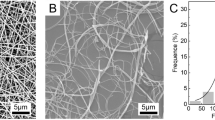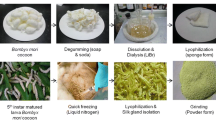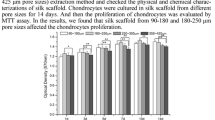Abstract
The three-dimensional functional nanofibrous microenvironment plays a key role in the regulation of cellular growth, because it can mimic the natural extracellular matrix structure. As an important nanofibrous scaffold, 3D functional nanofibers display broad application prospects in biomedical areas, such as tissue engineering, drug release, and biosensors. Recently, these functional nanofibrous scaffolds based on biocompatible natural materials with excellent flexibility and biochemical characteristics show great potential in tissue engineering applications. Herein, we prepared 3D chondroitin sulfate surface-modified silk nanofibers (3D CS-SNFs) using a combination of electrospinning and chemical grafting methods. The as-prepared 3D CS-SNFs exhibited excellent biocompatible properties. Moreover, there are numerous deeply interconnected pores (larger than 20 µm) for enhanced cellular entry into CS-SNFs and for 3D cell culture in vitro. The 3D CS-SNFs are beneficial to cell adhesion, nutrient delivery, and excretion of excrement, which provides healthy growth environment and living conditions for those cells that penetrate into the interior of the scaffold. Our results indicate that the 3D CS-SNFs show much higher degrees of promotion of bone marrow mesenchymal stem cells adhesion and osteogenic differentiation, as compared with the 3D raw silk nanofibers. These results demonstrate that the as-prepared 3D CS-SNFs could provide a suitable 3D microenvironment for cellular growth, adhesion, and excellent osteogenic differentiation. This work paves a new way for 3D cell culture construction for damaged bone repair and regeneration.









Similar content being viewed by others
References
Abbott RD, Kimmerling EP, Cairns DM, Kaplan DL (2016) Silk as a biomaterial to support long-term three-dimensional tissue cultures. ACS Appl Mater Interfaces 8:21861–21868
Bai SM, Zhang WM, Lu Q, Ma QH, Kaplan AL, Zhu SS (2014) Emerging chitin and chitosan nanofibrous materials for biomedical applications. J Mater Chem B2:6590–6600
Besheli NH, Mottaghitalab F, Eslami M, Gholami M, Kundu SC, Kaplan DL, Farokhi M (2017) Sustainable release of vancomycin from silk fibroin nanoparticles for treating severe bone infection in rat tibia osteomyelitis model. ACS Appl Mater Interfaces 9:5128–5138
Chwalek K, Tang-Scjomer MD, Omenetto FG, Kaplan DL (2015) In vitro bioengineered model of cortical brain tissue. Nat Protoc 9:1362–1373
Cohen-Karni T, Jeong KJ, Tsui JH, Reznor G, Mustata M, Wanunu M, Graham A, Marks C, Bell DC, Langer R, Kohane DS (2012) Nanocomposite gold-silk nanofibers. Nano Lett 12:5403–5406
Ding FY, Deng HB, Du YM, Shi SW, Wang Q (2014) Emerging chitin and chitosan nanofibrous materials for biomedical applications. Nanoscale 6:9477–9493
Ding BY, Wahid MA, Wang ZJ, Xie C, Thakkar A, Prabhu S, Wang J (2017) Triptolide and celastrol loaded silk fibroin nanoparticles show synergistic effect against human pancreatic cancer cells. Nanoscale 9:11739–11753
Feng ZQ, Wang T, Zhang B, Li JC, Jin L (2015) Soft graphene nanofibers designed for acceleration of nerve growth and development. Adv Mater 27:6462–6468
Jin L, Wang T, Feng ZQ, Michelle LK, Wu JH, Mo SJ, Jiang Q (2013) A facile approach for core/shell PEDOT nanofiber mats with superior mechanical properties and biocompatibility. J Mater Chem B 1:1818–1825
Jin L, Feng ZQ, Wang T, Ren ZZ, Ma SS, Wu JH, Sun DP (2014a) A novel fluffy hydroxylapatite fibers scaffold with deep interconnected pores designed for three-dimensional cells culture. J Mater Chem B2:129–136
Jin L, Yue D, Xu ZW, Liang GB, Zhang YL, Zhang JF, Zhang XC, Wang ZL (2014b) Fabrication, mechanical properties, and biocompatibility of reduced graphene oxide-reinforced nanofiber mats. RSC Adv 4:35035–35041
Jin L, Zeng ZP, Shreyas K, Yue D, Bao JN, Wang ZL, Zhang YL (2015) Synergistic effects of a novel free-standing reduced graphene oxide film and surface coating fibronectin on morphology, adhesion and proliferation of mesenchymal stem cell. J Mater Chem B 3:4338–4344
Jin L, Xu QW, Wu SY, Shreyas K, Li C, Huang JB, Zhang YL, Wang ZL (2016a) Synergistic effects of conductive three-dimensional nanofibrous microenvironments and electrical stimulation on the viability and proliferation of mesenchymal stem cells. ACS Biomater Sci Eng 2:2042–2049
Jin L, Zeng ZP, Shreyas K, Wu DC, Zhang YL, Wang ZL (2016b) Biocompatible, free-standing film composed of bacterial cellulose nanofibers/graphene composite. ACS Appl Mater Interfaces 8:1011–1018
Jin L, Xu QW, Li C, Huang JB, Zhang YL, Wang ZL (2017a) Engineering 3D aligned nanofibers for regulation of cell growth behavior. Macromol Mater Eng 302:1600448–1600457
Jin L, Xu QW, Shreyas K, Li C, Zhang YL, Wang ZL (2017b) Fabrication and characterization of three-dimensional (3D) core-shell structure nanofibers designed for 3D dynamic cell culture. ACS Appl Mater Interfaces 9:17718–17726
Kim CS, Yang YJ, Bahn SY, Cha HJ (2017) A bioinspired dual-crosslinked tough silk protein hydrogel as a protective biocatalytic matrix for carbon sequestration. NPG Asia Mater 9:391–391
Kumar M, Coburn J, Kaplan DL, Mandal BB (2016) Immuno-informed 3D silk biomaterials for tailoring biological response. ACS Appl Mater Interfaces 8:29310–29322
Landau S, Szklanny AA, Yeo GC, Shandalov Y, Kosobrodova E, Weiss AS, Levenberg S (2017) Tropoelastin coated PLLA–PLGA scaffolds promote vascular network formation. Biomaterials 122:72–82
Lee JK, Huwe LW, Paschos N, Aryaei A, Gegg CA, Hu JC, Athanasiou KA (2017) Tension stimulation drives tissue formation in scaffold-free systems. Nat Mater 16:864–873
Li SR, Nih LR, Bachman H, Fei P, Li YL, Nam E, Dimatteo R, Carmichael ST, Barker TH, Segura T (2017) Hydrogels with precisely controlled integrin activation dictate vascular patterning and permeability. Nat Mater 16:953–961
Martín-Moldes Z, Ebrahimi D, Plowright R, Dinjaski N, Perry CC, Buehler MJ, Kaplan DL (2017) Intracellular pathways involved in bone regeneration triggered by recombinant silk-silica chimeras. Adv Funct Mater 28:1702570
Min K, Kim S (2017) Colored and fluorescent nanofibrous silk as a physically transient chemosensor and vitamin deliverer. Sci Rep 71:5448–5448
Naskar D, Ghosh AK, Mandal M, Das P, Nandi SK, Kundu SC (2017) Dual growth factor loaded nonmulberry silk fibroin/carbon nanofiber composite 3D scaffolds for in vitro and in vivo bone regeneration. Biomaterials 136:67–85
Nilebäck L, Chouhan D, Jansson R, Widhe M, Mandal BB, Hedhammar M (2017) Silk-silk interactions between silkworm fibroin and recombinant spider silk fusion proteins enable the construction of bioactive materials. ACS Appl Mater Interfaces 9:31634–31644
Pan JF, Yuan L, Guo CA, Geng XH, Fei T, Fan WS, Li S, Yuan HF, Yan ZQ, Mo XM (2014) Fabrication of modified dextran-gelatin in situ forming hydrogel and application in cartilage tissue engineering. J Mater Chem B2:8346–8360
Parekh G, Shi Y, Zheng J, Zhang X, Leporatti S (2018) Nano-carriers for targeted delivery and biomedical imaging enhancement. Ther Deliv 9(6):451–468
Raia NR, Partlow BP, McGill M, Kimmerling EP, Ghezzi CE, Kaplan DL (2017) Enzymatically crosslinked silk-hyaluronic acid hydrogels. Biomaterials 131:58–67
Ribeiro VP, Silva-Correia J, Nascimento AI, Maorais AS, Marques AP, Ribeiro AS, Silva CJ, Bonifácio G, Sousa RA, Oliveira JM, Oliveria AL, Reis RL (2017) Silk-based anisotropical 3D biotextiles for bone regeneration. Biomaterials 123:92–106
Rockwood DN, Preda RC, Yücel T, Wang XQ, Lovett ML, Kaplan DL (2011) Materials fabrication from Bombyx mori silk fibroin. Nat Protoc 6:1612–1631
Savoji H, Maire M, Lequoy P, Liberelle B, Crescenzo GD, Ajji A, Wertheimer MR, Lerouge S (2017) Combining electrospun fiber mats and bioactive coating for vascular graft prostheses. Biomacromolecules 18:303–310
Selvaraj S, Fathima N (2017) Fenugreek incorporated silk fibroin nanofibers a potential antioxidant scaffold for enhanced wound healing. ACS Appl Mater Interfaces 9:5916–5926
Shi LY, Wang FL, Zhu W, Xu ZP, Fuchs S, Hilborn J, Zhu LJ, Ma Q, Wang YJ, Weng XS, Ossipov DA (2017) Self-healing silk fibroin-based hydrogel for bone regeneration: dynamic metal-ligand self-assembly approach. Adv Funct Mater 27:1700951
Subia B, Rao RR, Kundu SC (2015) Silk 3D matrices incorporating human neural progenitor cells for neural tissue engineering applications. Polym J 47:819–825
Sun YL, Li Q, Sun SM, Huang JC, Zheng BY, Chen QD, Shao ZZ, Sun HB (2015) Aqueous multiphoton lithography with multifunctional silk-centered bio-resists. Nat Commun 6:8612–9612
Sun BB, Wu T, Wang J, Li DW, Wang J, Gao Q, Bhutto MA, El-Hamshary H, Al-Deyab SS, Mo XM (2016) Polypyrrole-coated poly(l-lactic acid-co-ε-caprolactone)/silk fibroin nanofibrous membranes promoting neural cell proliferation and differentiation with electrical stimulation. J Mater Chem B 4:6670–6679
Tansil NC, Li Y, Teng CP, Zhang SY, Win KY, Chen X, Liu XY, Han MY (2011) Intrinsically colored and luminescent silk. Adv Mater 23:1463–1466
Trappmann B, Baker BM, Polacheck WJ, Choi CK, Burdick JA, Chen CS (2017) Matrix degradability controls multicellularity of 3D cell migration. Nat Commun 8:371–371
Vergaro V, Scarlino F, Bellomo C, Rinaldi R, Vergara D, Maffia M, Baldassarre F, Giannelli G, Zhang X, Lvov YM, Leporatti S (2011) Drug-loaded polyelectrolyte microcapsules for sustained targeting of cancer cells. Adv Drug Deliv Rev 14(9):847–864
Wang CY, Wu SY, Jian MQ, Xie JR, Xu LP, Zheng QS, Zhang YY (2016) Silk nanofibers as high efficient and lightweight air filter. Nano Res 9:2590–2597
Xiao LY, Lu GZ, Lu Q, Kaplan DL (2016) Direct formation of silk nanoparticles for drug delivery. ACS Biomater Sci Eng 2:2050–2057
Xiao LY, Liu SS, Yao DY, Ding ZZ, Fan ZH, Lu Q, Kapla DL (2017) Fabrication of silk scaffolds with nanomicroscaled structure and tunable stiffness. Biomacromolecules 18:2073–2079
Yi SX, Dai FY, Ma Y, Yan TS, Si Y, Sun G (2017) Ultrafine silk-derived nanofibrous membranes exhibiting effective lysozyme adsorption. ACS Sustain Chem Eng 5:8777–8784
Zhang WJ, Feng C, Yang GZ, Li GL, Ding X, Wang SY, Dou YD, Zhang ZY, Chang J, Wu CT, Jiang XQ (2017) 3D-printed scaffolds with synergistic effect of hollow-pipe structure and bioactive ions for vascularized bone regeneration. Biomaterials 135:85–95
Acknowledgements
This research was supported by the National Natural Science Foundation of China (21504082, 81600775 and 51572303), and L. J. acknowledges the program of Innovative Talent (in Science and Technology) in University of Henan Province (17HASTIT007), Key Laboratory of Polymeric Composite and Functional Materials of Ministry of Education for funding (PCFM-2017-04) and Excellent Talent Foundation of Henan Province (No. 154200510027).
Author information
Authors and Affiliations
Corresponding authors
Ethics declarations
Conflict of interest
The authors declare no competing financial interest.
Additional information
Publisher’s Note
Springer Nature remains neutral with regard to jurisdictional claims in published maps and institutional affiliations.
Electronic supplementary material
Below is the link to the electronic supplementary material.
Rights and permissions
About this article
Cite this article
Jin, L., Zhang, X., Li, Z. et al. Three-dimensional nanofibrous microenvironment designed for the regulation of mesenchymal stem cells. Appl Nanosci 8, 1915–1924 (2018). https://doi.org/10.1007/s13204-018-0877-7
Received:
Accepted:
Published:
Issue Date:
DOI: https://doi.org/10.1007/s13204-018-0877-7




